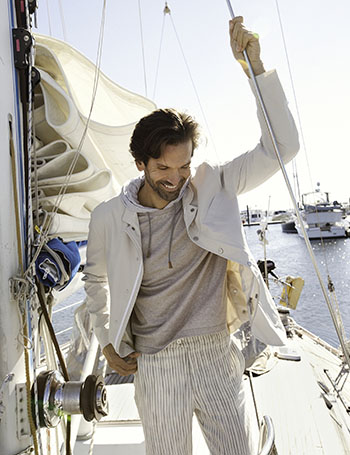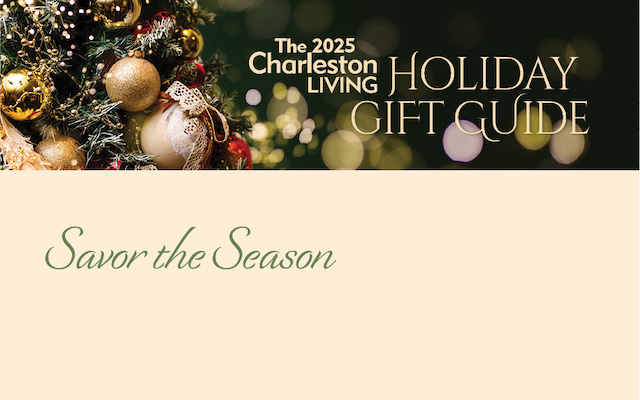Real-Life Sea Inspiration
04 Mar 2022
College of Charleston marine geology professor launches Oceanica Designs
By Sophia Rodriguez

It’s fortunate if you get to work in a field you love for your entire career. It’s a rare treasure if you get to do it twice in a lifetime—and fold that second career into your retirement plans.
Dr. Leslie Sautter is one of those fortunate people. She’s spent the last three decades teaching marine geology at College of Charleston and uncovering the mysteries of the seafloor.
“In the early years, my work was in the area of using the microfossils to understand climate. But I’m now hooked on seafloor mapping and ocean exploration, especially because I can go out to sea with students to map, explore and learn together,” Sautter said.
So it may surprise you to learn that Sautter is planning to retire early. This summer, in fact. That’s because she has another passion up her sleeve. Her online shop, Oceanica Designs, sells sea-themed gifts like pillows, plates and baby clothes as well as photography prints and canvases.
“A small part of why I chose to retire early is so I can attempt to grow the business while I’m still interested and relatively young,” she said. “I have always had a strong creative streak and have always wanted to be an entrepreneur. By being an ocean scientist and working at sea with some awesome marine biologists, I was always interested in the ‘critters’ and absolutely loved my invertebrate zoology course in college.”
When Sautter began teaching educators about marine science, she knew she had to develop engaging activities that would ignite their interest. During a marine educators’ conference, she learned gyotaku, the Japanese art of fish printing. Gyotaku, which translates into “fish” (gyo) and “rubbing” (taku), emerged in the 19th century. It was a way for fishermen to record and compare what they caught out at sea.
At the time, Sautter utilized it to teach fish morphology, or the shape of their features. This was a way to show other teachers how a particular creature’s morphology helped them thrive in their environments.
It wasn’t until a fisherman brought her an octopus on ice that had died in a trawl net that she saw another purpose for gyotaku. “[When I printed the octopus], the result was amazing, and I knew I could do gyotaku as a craft. After many years of thinking about it, I used the octopus print as a logo and started Oceanica Designs in 2006.”
It’s easy to see how her “day job” at CofC informs her art. Her designs center around prints of fish, crabs, seahorses and octopuses. In 2001, the professor founded Project Oceanica, which integrates her oceanographic exploration with educational resources she developed for students and educators alike.
The website www.oceanica.cofc.edu includes underwater video galleries, aerial photos of South Carolina’s barrier islands and their ever-changing coastlines, and information about multibeam sonar seafloor mapping.
“The seafloor mapping is an incredible art form and I love working with the software. I’ve used some of the images on coasters and people love them. Even the microfossils I study have made their way into my designs,” via scanning electron microscope images. “The video of the deep seafloor includes so many organisms, which I also find to be artfully beautiful,” she said.
Sautter does gyotaku once a year — a process she describes as “messy, stinky, and fun”— so she can obtain new prints. Then she scans the finished prints, cleans them up with photo editing software and flexes her creative muscles by changing the size, color and positioning of the different sea creatures.
“I think the octopus is my all-time favorite, although I also love the flying fish collage that I call ‘flight school.’ One night when I was at sea on a research vessel, a the fish ‘flew’ up onto the deck to escape a predator. Sadly, he was found deceased the next morning. So, I immortalized him in print.”
Mugs with Sautter’s designs have been sold at Muddy Waters Coffee on James Island. Some of her work can be found at the Sea Island Farmers Market on Johns Island, and her hope is that her designs can be featured at more markets in the Lowcountry.
“I love talking to customers, telling all my stories and educating them about marine geology just a little,” she said.
Sautter is looking forward to this next chapter of her career and life.
“I have always used my brain’s right hemisphere to do art and to play music while being a nerdy left-brain scientist. Teaching allows me to bring them together all the time, and Oceanica Designs is a perfect way to extend my interests outside of the classroom and lab,” she said.
To learn more, visit www.oceanicadesigns.com.











